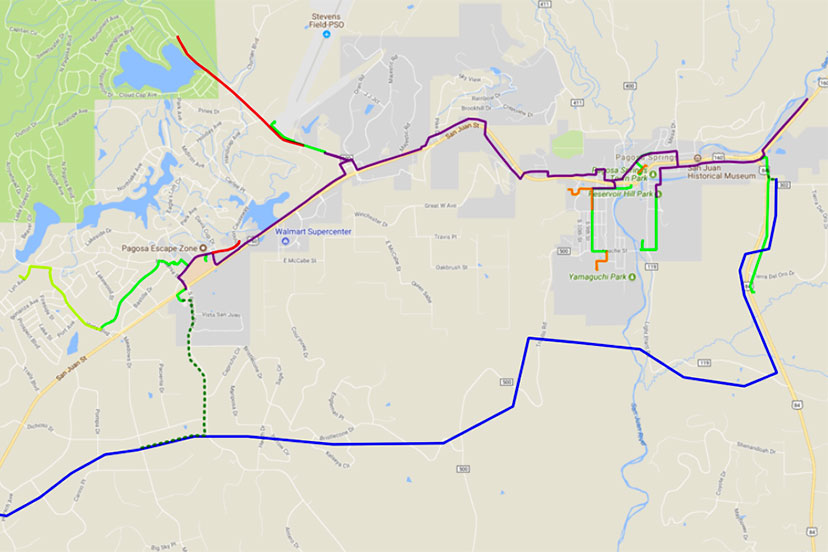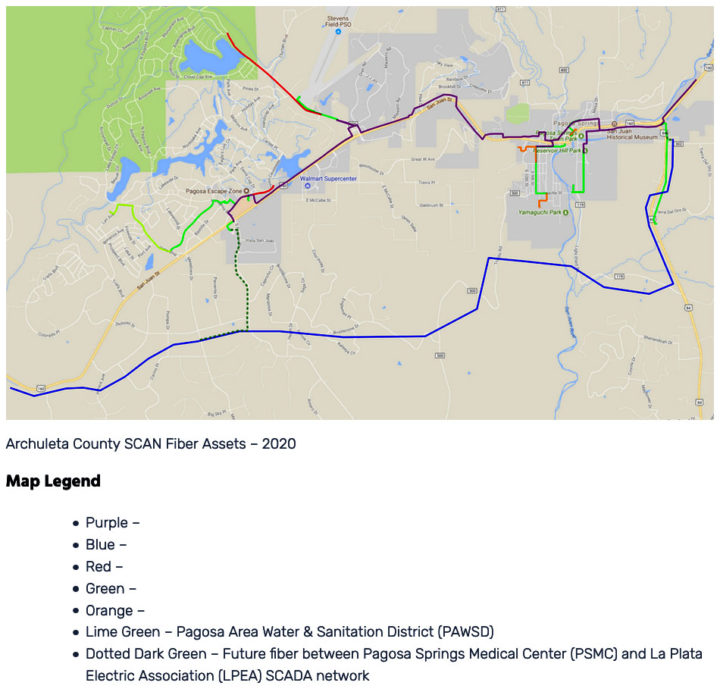After we finished discussing why the utility known as “rural broadband” is handled mainly by private companies rather than by co-op associations or by local governments, La Plata Electric Association (LPEA) Vice President Dan Harms and I talked about LPEA’s Internet plans.
Those of us who use LPEA electricity are members of the co-operative, and we vote for the Board of Directors, and occasionally, we get to approve proposed changes to the co-op’s policies. When LPEA gets an unexpected windfall, they share the benefits with their members. It’s pretty much like a government organization; LPEA exists to serve us, the members… not a group of private shareholders.
Five of the 22 rural electric co-ops in Colorado have already gotten into the broadband business, or are getting into it, including Delta-Montrose Electric Association (DMEA), with their Elevate broadband network. From the DMEA website:
As your local electric co-op we know our true purpose is so much more than poles and wires — we work every day to improve the quality of life in our communities. That commitment lead us to launch Elevate Fiber in 2016, a local fiber Internet company that provides the fastest, most reliable internet to the citizens of Paonia, Hotchkiss, Orchard City, Cedaredge, Olathe, Montrose, and beyond. And we say fastest, we mean (for real):
150 Mbps (fast) for $54.95/mo.
1 Gig (supersonic fast) for $79.95/mo.
For comparison with Archuleta County, CenturyLink sells (up to) 20 Mbps for $49 a month (“promo rate”) but has a cap on how much bandwidth you’re allowed.
Empire Electric Association & La Plata Electric Association jointly own Fast Track Communications, which serves the Durango area. San Luis Valley Rural Electric Cooperative owns Ciello. Southeast Colorado Power Association, operates SECOM. Yampa Valley Electric Association runs Luminate Broadband.
According to Mr. Harms, LPEA might — someday — deliver high-speed fiber-based broadband to Archuleta County, in the same way DMEA is serving the Delta-Montrose area. Or maybe not. LPEA has established a working group to analyze the pros and cons of getting into the regional broadband game, and one of the issues, for a future build-out of an Internet fiber network, is the competitive playing field in Pagosa Springs, with three existing land-based providers, and two satellite providers.
Or shall we say, three satellite providers, if we count Elon Musk’s StarLink project — currently accepting broadband orders. Or maybe four satellite providers, if we count Amazon’s proposed Kuiper Constellation. Five if we count the OneWeb satellites, and six if we count Canada-based Lightspeed/Telesat.
Seven, if we imagine (in our wildest dreams) the Chinese government allowing US users to hook up to its Gou Wang satellite constellation?
A co-op like LPEA is directly responsible to its members, and must pay its own way while charging reasonable fees for its services. Does a multi-million-dollar investment into Internet fiber infrastructure make economic sense — at a time when multiple satellite companies are threatening to turn the broadband playing field on its head?
LPEA certainly needs to decide whether that makes sense. Over here in Archuleta County, perhaps our BOCC also has some doubts about whether, or how, to invest in broadband services. In our previous installments of this editorial series, we discussed a $2.7 million proposal from the local, government-funded Broadband Services Management Office, to get itself involved in some major fiber installations here in Archuleta County.
For an insider’s view of the broadband situation, I sat down with Kristie Wayward last week, who was, until recently, employed by one of our three land-based Internet providers, and who has been paying attention to the development of broadband resources in Archuleta County.
Ms. Wayward:
“I’m trying to figure out who’s doing what. I know Martin & Martin is doing stuff for the County government right now. They do some of the stuff for Visionary Broadband. But I don’t know who’s doing all of these poles? Is that DB Tech?… I know the County government is planning to replace some of the SCAN fiber, because there are some problems with those SCAN runs.”
Starting back in 2010, the Town of Pagosa Springs and the Archuleta County government — working with the Southwest Colorado Council of Governments and USA Communications — helped fund the installation of the Southwest Colorado Access Network (SCAN)… a fiber cable network connecting certain government buildings, downtown and uptown. The installation was funded in part by a $4 million grant from the Colorado Department of Local Affairs (DOLA), and was officially “completed” in 2014.
But problems have persisted. As we know, local government is not in the business (currently) of providing excellent broadband service, so certain things have tended to… fall through the cracks?
Here’s a map of the “SCAN” network I found last week on our government-funded Broadband Services Management Office (BSMO) website.
Although the longest run of fiber (in blue) might appear, from the map description, to be part of the “SCAN Fiber Assets” — it’s my understanding that this run actually belongs to the LPEA electric co-op, not to local governments. I wonder if there are other parts of the system that don’t actually belong to our local governments, as suggested by Ms. Wayward.
The “Map Legend” is mostly devoid of useful information… as is the website, in general. I suppose we could forgive the lack of complete and timely information, if the BSMO were operated by volunteers. But in fact, the co-managers are rather well-paid, by Pagosa standards.
Ms. Wayward expressed some other concerns about the SCAN network.
“When I ask about the problems, I get two different answers to that question. But my honest opinion is that the SCAN project… it’s questionable who has ownership of what. USA Communications leveraged that project pretty hard, to their own advantage, and as far as I know, there’s not a lot of good paperwork that was ever signed. So there’s issues, where USA ran cable alongside the ones for the Town and County… or there were [places] where it was completely Town and County — like, where the fiber that goes directly to the buildings. But the fiber that goes between the buildings, the extra strands — there have been some issues [with access].
“And I think that’s why they’re in the process of adding more lines, to bypass parts of the SCAN network. Because I don’t know whether Zito is playing nice with the Town and County.”
Zito Media purchase USA Communications in April 2019.
“But it’s screwed up. It never should have ended up that way… The problem was, the SCAN project was low on money, so it wasn’t all completed as planned. PAWSD was supposed to be part of it, and I think PAWSD had to pay DB Tech to finish their connections.
“If I remember right, the money ran out along the way, and some of the splicing is still not completed…”
Sounds complicated, as Ms. Wayward describes it.


